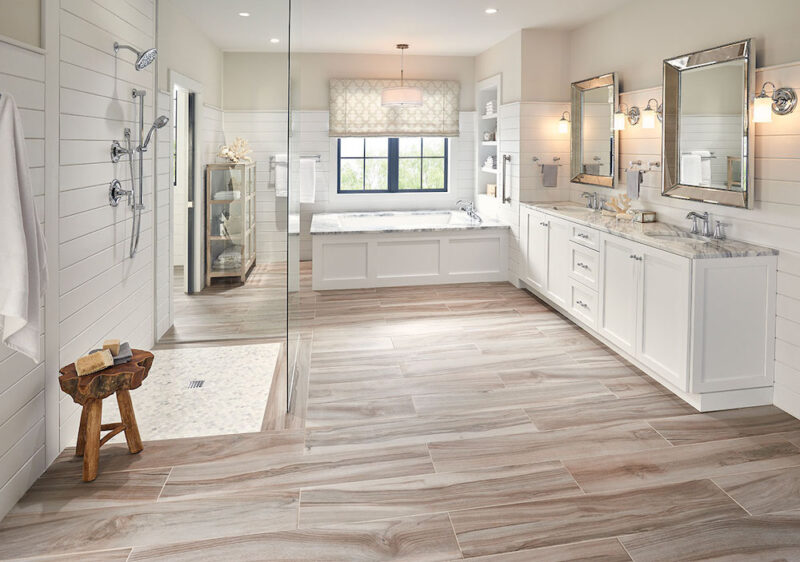The bathroom is one of the most intimate and functional spaces in a home, yet it offers endless opportunities to showcase your personal style.
Choosing the right flooring is essential to achieve a harmonious look that enhances your bathroom’s aesthetic.
With so many materials, patterns, and colors available, finding the perfect fit can feel overwhelming.
This guide will help you navigate the options and select flooring that complements your bathroom’s design and meets your practical needs.
Why Flooring Matters in Bathroom Design

The flooring in your bathroom does more than serve as a surface to walk on. It anchors the design, sets the mood, and can even make the space feel larger or cozier.
Beyond aesthetics, it must also withstand high moisture levels, frequent cleaning, and heavy foot traffic. Striking the perfect balance between functionality and visual appeal is key when choosing your bathroom floor.
Assess Your Bathroom’s Aesthetic
Before diving into flooring options, take a moment to define your bathroom’s overall aesthetic. Is it modern and minimalist, vintage and charming, or spa-inspired? Each design style has flooring materials and finishes that work better than others.
For instance:
- Modern Bathrooms: Sleek surfaces like polished porcelain or large bathroom floor tiles in neutral tones amplify a contemporary vibe.
- Rustic Bathrooms: Distressed wood-look tiles or natural stone can add warmth and texture.
- Luxury Bathrooms: Marble tiles or mosaic patterns exude elegance and sophistication.
Matching the flooring to the style ensures a cohesive and intentional design.
Consider the Functional Requirements

Since bathrooms are prone to water spills, humidity, and temperature fluctuations, it’s crucial to choose flooring that can handle these challenges. Consider the following factors:
1. Water Resistance
The flooring must resist water to prevent warping, staining, or mold growth. Tiles like ceramic, porcelain, and natural stone are excellent choices for their water resistance.
2. Durability
Bathroom floors endure daily wear and tear. Opt for materials that are scratch-resistant and long-lasting, especially in households with children or pets.
3. Slip Resistance
Safety is paramount, especially in wet areas. Choose flooring with a textured surface or a slip-resistant finish to prevent accidents.
4. Ease of Maintenance
Bathrooms require frequent cleaning to maintain hygiene. Select flooring that’s easy to clean and doesn’t require special treatments.
Popular Flooring Options for Bathrooms

Each type of flooring brings unique qualities to the table. Here are some popular options to consider:
1. Ceramic Tiles
Ceramic tiles are a classic choice for bathrooms. They are affordable, water-resistant, and available in an array of colors, patterns, and sizes. For added flair, consider textured or patterned tiles to create a statement.
2. Porcelain Tiles
Porcelain tiles are denser and more durable than ceramic. Their low water absorption rate makes them ideal for bathrooms. Choose from matte or glossy finishes depending on your aesthetic preference.
3. Vinyl Flooring
Vinyl is a cost-effective and versatile option that mimics the look of wood, stone, or tile. It’s water-resistant, durable, and comfortable underfoot, making it a great choice for families.
4. Natural Stone
For a luxurious look, natural stone like marble, slate, or travertine is a timeless option. However, these materials require sealing and regular maintenance to protect against moisture.
5. Engineered Wood
If you desire the warmth of wood in your bathroom, opt for engineered wood. It’s more water-resistant than solid hardwood and adds a cozy, organic touch.
6. Concrete
Polished concrete offers a minimalist, industrial aesthetic. It’s durable, water-resistant, and can be customized with stains or textures for added visual interest.
Color and Pattern Choices

The color and pattern of your flooring significantly impact your bathroom’s ambiance. Light-colored floors can make a small bathroom appear larger, while darker tones add drama and depth. Patterns such as herringbone, chevron, or geometric designs can create visual interest and serve as a focal point.
When selecting colors, consider the walls, cabinetry, and fixtures in your bathroom. Harmonizing the palette ensures a cohesive look. Alternatively, you can opt for contrasting flooring to make a bold statement.
Enhancing the Design with Grout
Don’t underestimate the role of grout in your flooring design. The color of the grout can either blend seamlessly with the tiles or create striking contrast. Matching grout to the tile color provides a uniform look, while contrasting grout highlights the pattern and geometry of the tiles.
Grout also serves a functional purpose by preventing water from seeping underneath the tiles. Be sure to choose a high-quality, water-resistant grout to maintain the integrity of your flooring.
Heating and Comfort Considerations
For added comfort, especially in colder climates, consider installing underfloor heating beneath your bathroom flooring. This feature works particularly well with tiles and stone, ensuring a warm and cozy experience every time you step out of the shower.
Sustainability Matters

If environmental impact is a concern, look for eco-friendly flooring options such as reclaimed wood, bamboo, or tiles made from recycled materials. These choices reduce your carbon footprint while still providing style and durability.
Final Thoughts
Choosing the perfect flooring for your bathroom involves considering aesthetics, functionality, and long-term performance.
Whether you prefer the classic appeal of bathroom floor tiles or the modern charm of polished concrete, prioritize materials that align with your style and practical needs.
The right flooring not only enhances the beauty of your bathroom but also ensures comfort and safety for years to come.


